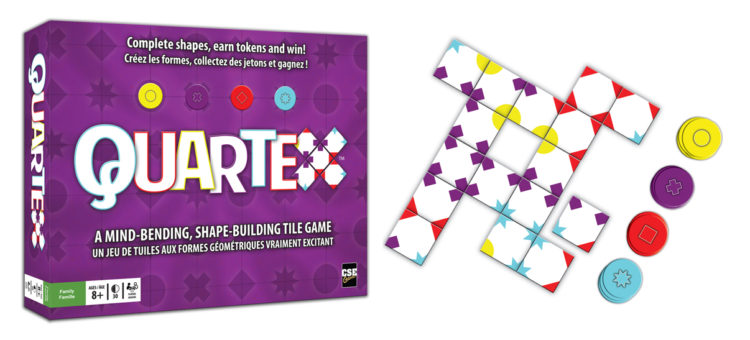Quartex is an engaging abstract strategy tile game for all ages. Known for its puzzle like approach to game play, this 2-5 player game allows students to develop skills in reasoning, fractions, patterns, visual spatial skills, symmetry, and more! Players are given square tiles that have a quarter of a shape on each corner. Players try to complete four-corner shapes by placing their tiles beside other tiles already in play to create an ever growing game board. There are four possible shapes: red square, purple cross, yellow circle, and a blue star. If a player completes a four-corner shape, they will earn a point token of that colour. But there is a fun twist- as the number of tokens collected increases, their values decrease! Sometimes less, is more. Because of this, every game of Quartex is unique, allowing for endless possibilities of game play and strategies to be used.
Click on this link for student resources: Quartex Student Record Sheets
Click on this link for teacher resources: Quartex Teacher Resource Sheets
Curriculum Connections
Coming soon.
Connections to Processes
Communication [C] : When students learn the game Quartex, there is discussion among the attributes of the different shapes on each tile and token. This allows students to see, hear, and discuss in mathematical language about the shapes and their symbolic representations. They communicate with mathematical terminology such as: part-to-whole, whole-to-part, attributes, symmetry, and more. During game play, players must communicate to justify their tile placement. Players also must communicate when an opponent is unable to place a tile. The possibilities are endless if teaching prompts are added to the mixture of communication. Once players start explaining their ideas about the tiles and symbols, teachers can prompt students with formal mathematical language.
Connections [CN] : It is important that students learn how to play Quartex themselves. The great thing about this game, is that it does not tell you the names, or attributes of the shapes. Therefore, students use their prior experiences to create their own descriptions and titles for the shapes. This game allows students to actively engage in with various shapes in a new context. Quartex has many possible connections to course materials (please see program of studies connections). Quartex also makes the course material relevant to learners and increases students’ willingness to participate and be actively engaged during class time.
Each time the students play Quartex, they will use their knowledge from the previous game to make predictions, known as the theoretical aspect. This allows students to expand their thinking by recognizing patterns from previous games and using them to make predictions (theoretical probability) (Alberta Education, 2014, p.34).
Students are continuously making connections with their tiles, and the tokens during game play. They are making connections with their developing number sense, geometric properties, and the concrete materials.
Mental Mathematics and Estimation [ME]: The twist in Quartex is that as the number of tokens collected increases, their value decreases. This means the value of the tokens evolve as the game advances. Players must be aware of this concept, and use mental mathematics in combination with cognitive strategies to win. Without the traditional paper and pencil strategy, players must estimate the number of points they will receive by knowing the number of unclaimed tokens. This enables students to improve computational fluency by developing efficient strategies for computing the possible points outcomes (Alberta Education, 2014, p.5). After playing the game, students develop the ability to use mental mathematics when visualizing their tile’s shapes to consider where they can place their tiles.
Problem Solving [PS]: No game of Quartex is ever the same. Quartex provides a multitude of opportunities for students to develop their own problem solving strategies by communicating, taking risks, and reasoning. Players must use logical and critical thinking, as well as adjust their strategy for each game. Students will apply their prior learning in new ways when playing multiple games of Quartex. No game of Quartex is alike, so students must continue to grow as problem solvers, and that requires a depth of conceptual understanding of geometric features, as well as transformations.
Reasoning [R] : During game play, players must use reasoning skills when an opponent is unable to place a tile. As the rules indicate, the opponent must show their tile, and the other player must try and find a location for that tile to fit, thus allowing for peers to communicate thei mathematical thinking and reasoning. Together they must analyze the problem, then if able, justify and defend their conclusion (where the tile should be placed).
Visualization [V] : The visualization aspect of Quartex provides learners with another method to develop a more in-depth mathematical understanding of shapes. Students use their tile manipulatives to visualize possible placements for their tiles. This game is a fantastic opportunity for students to interpret and describe visual representations of shapes on their tiles through spatial reasoning. Students use spatial visualization and reasoning to describe relationships between the shapes. Quartex also allows students to visualize transformations of shapes.
